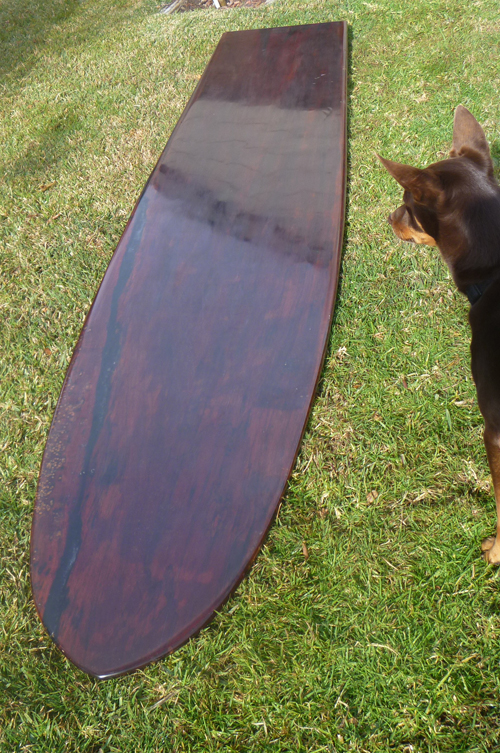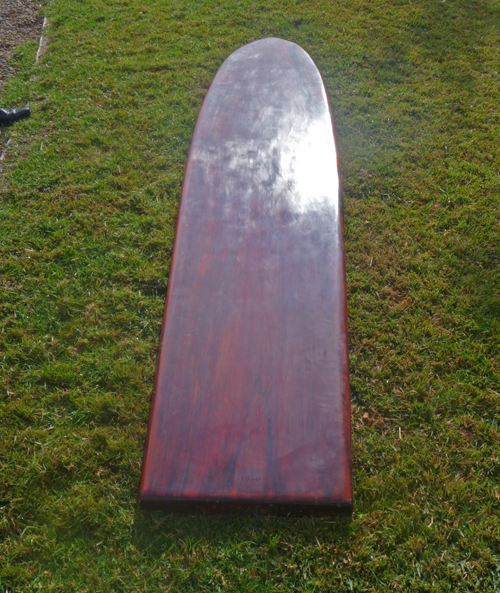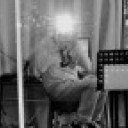Bruce Channon: Wooden Surfboard Maker
Most surfers would know Bruce Channon through his photography and his involvement with surfing magazines. Some may remember that he was also a successful competitive surfer at the transition point from longboards to shortboards, and a few may also remember him as a craftsman in the surfboard industry working for a range of manufacturers including Midget Farrelly. His role in recreating the wooden surfboards of previous eras though is less well known.
Bruce recently spoke with blindboy about his overlooked interest.
Blindboy: So how did you get interested in woodworking?
Bruce Channon: I had to do a surfboard for Australian Longboarding Magazine. They came to me and said "Do you want to make a board out of this kit that we are offering for sale?" I said OK and found that it was really a fun thing to do. So after that a friend of mine made one, then he made another one and I made another one and it has continued on from there.
I also inherited a bit of Australian Red Cedar that drifted ashore at Nambucca Heads a few years ago and we think it is from when they originally cut down the Australian Red Cedar in the 1850s, the last Red Cedar was probably cut down in the 1850s and 1860s. Our theory is that it was stuck in a river bank for 150 years because of the proportions and there are adze marks in it that show that it was probably felled in the 1850s. Cedar trees that big? They just don't cut them down anymore.
 We think that it was caught in the riverbank and then one of the big floods we have had in the last ten years has flushed it out and sent it out to sea. So this piece of timber that came ashore at Nambucca Heads was a flitch, the same proportions as the way they used to cut down the old Red Cedar trees. Four and a half metres long 750 wide, 450 high? And I inherited a slice of it, 'cos my brother-in-law found it. The slice he gave me was a bit that had loads of worm damage on one side that he didn't want so I fixed up one side and the other side is beautiful so I made a recreation of a Snowy McAlister board from the 1920s. It's solid Australian Red Cedar and weighs 40kg! Quite an experience to surf.
We think that it was caught in the riverbank and then one of the big floods we have had in the last ten years has flushed it out and sent it out to sea. So this piece of timber that came ashore at Nambucca Heads was a flitch, the same proportions as the way they used to cut down the old Red Cedar trees. Four and a half metres long 750 wide, 450 high? And I inherited a slice of it, 'cos my brother-in-law found it. The slice he gave me was a bit that had loads of worm damage on one side that he didn't want so I fixed up one side and the other side is beautiful so I made a recreation of a Snowy McAlister board from the 1920s. It's solid Australian Red Cedar and weighs 40kg! Quite an experience to surf.
Then I was just about to make a 14 footer, I had all the timber here ready and Mick Dooley came around and he's good friends with Gordon Woods, the famous surfboard maker and Gordon had half made an okanui but decided he didn't want to finish it because it was too much work. So he said to me, "If you know someone who would like to finish this board they can have it." I then finished the okanui, so I've got one of them. So I am working my way through the eras of woodworking. A bit of fun!
And you had an alaia at one stage.
Oh yeah, sorry, I started with an alaia. The very first thing I had was an alaia and that was because I went to Noosa and I saw these young kids ripping shit on the alaias and thought "How good would it be to be that young and that fit and be able to do it." So I thought, "Bugger it, I'll have a go at it." I made one and I spent six months trying to learn to surf the thing and in that six months I probably got 12 good waves and those waves were all a fantastic experience.
I would recommend anyone to go and buy a bit of paulownia, make their own alaia and have a go at it because the experience of having a bit of wood and hopping in the surf and actually standing up, even if you don't rip shit on it is an amazing experience. You have that thought that if I was on a deserted island I could find a bit of timber, hack it away and if there was perfect surf going by, I could go out and surf a wave and you can.
 So technically does much of it come from ancient Hawaiian techniques or is it all modern woodworking skills?
So technically does much of it come from ancient Hawaiian techniques or is it all modern woodworking skills?
There's a combination really. I use a lot of the modern things but I've also got things like draw knives and spoke shaves which are old tools and not dissimilar to what the Hawaiians did. I've sort of been interested in that whole Hawaiian recreation thing of Tom Stone, he has a Hawaiian name now, Tom Pohaku. He's all about recreating the old Hawaiian surfboards and having people make them. Things like you are supposed to bleed on it, if you are making a surfboard or something in the old school and that keeps it all together. So I'm tuned into that because I am good friends with Paul Joske and he's very much of that ilk.
So what about surfing? What sort of conditions have you surfed them in?
I've been very careful! I haven't taken on Dee Why Point! I am really careful to take them out where I am not going to kill anyone. Gentle rolling waves. The 40kg redwood one takes a while to build up inertia, so you can turn around for a wave and start paddling and you don't go anywhere for 20 seconds, so you can't paddle onto waves in a conventional manner. You have to like head out in the rip and do a big curving turn and hope that there is a wave while you are doing the curve that you can pick up. There are different techniques involved but they're all amazing. When you get to your feet there is a similarity with them from the alaia through to okanui and the 14 footer because they don't have fins and they have all that weight, it's all about edge control. They take you a lot of the way and they find their spot in the wave which is the most interesting thing. You think you are going to be in trouble and the board just finds that perfect slot in the wave and away you go. It's a fun sensation.
So how many people are doing this?
Not that many really. Wegener started it because of his interest in the alaia, Tom Wegener from Noosa, and he's been very generous with telling people how to make alaias, you can go on to YouTube and there is a full instruction on how to make an alaia, and he sells the blanks for only about $100. He's been very open and he wants people to go and make them which is really cool. There are not that many other people who are really doing it.


Comments
Great story , finding that cedar would have been a dream.
Great story , finding that cedar would have been a dream.
Excuse my ignorance, but why is it so hard to come across Australian Cedar?